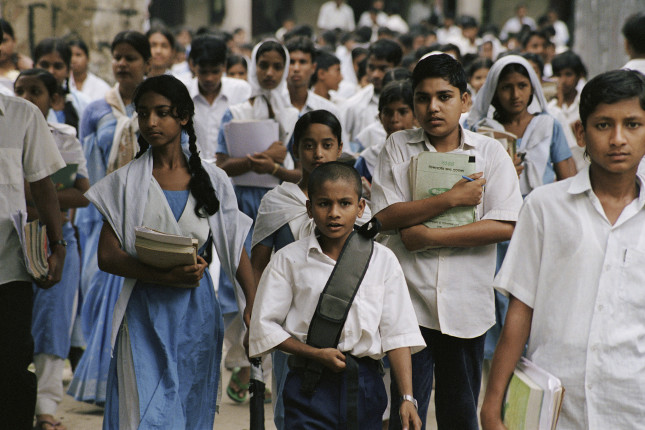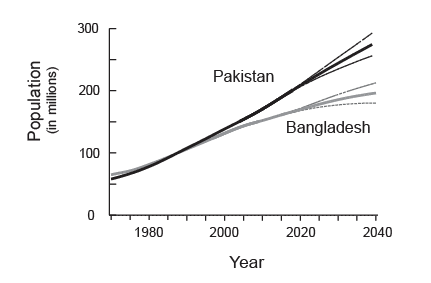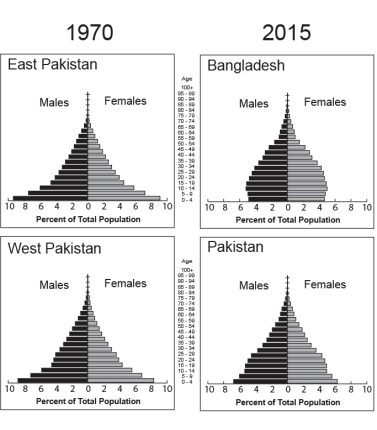-
Bangladesh and Pakistan: Demographic Twins Grow Apart

While the World Population Prospects—the UN Population Division’s demographic estimates and projections—will never land on anyone’s non-fiction best-seller list, the latest version holds some noteworthy true stories. And the most remarkable demographic story of all may be Bangladesh’s.
UN figures indicate that this densely populated South Asian nation, once identified with natural catastrophes and rock-concert relief, is on the cusp of its demographic window—a period of favorable age structures that researchers associate with an increased pace of development and a more stable political future. Bangladesh is already a solid member of the World Bank’s lower middle-income class. According to a set of statistical models that we have developed, by 2030 Bangladesh appears to have an even chance of reaching the Bank’s upper middle-income class (roughly US$4,000 to $12,000 per capita annually). For a country that Henry Kissinger famously dubbed “a basket case” at independence in 1971, that prospect is impressive.
This remarkable turnaround is not a big surprise to international health specialists. In 1975, the government in Dhaka began collaborating with the International Centre for Diarrheal Disease Research, Bangladesh (ICDDR/B) to initiate a program of community-based contraceptive distribution in Matlab subdistrict, a long-term health and demographic surveillance site. By 1977, the ICDDR/B’s project had trained a cadre of 80 Family Village Workers to offer counseling and, initially, pills and condoms alongside a select set of maternal and child health interventions. This successful approach—much of it funded by USAID and supported with its technical assistance—helped trigger demand for modern contraception and formalize Bangladesh’s public health supply chain. As the rate of contraceptive use grew through the 1980s and 1990s, the country’s total fertility rate (TFR), an estimate of the average lifetime number of children that women will bear, declined steeply, advancing the median age of Bangladesh’s population and promoting related progress in education, child health, and nutrition.
An Experiment in State Building
This demographic success story transformed Bangladesh into one-half of a rare comparative experiment in building state capacity. When Bangladesh (formerly East Pakistan, the eastern provincial wing of Pakistan) achieved independence in 1971, its demographic indicators were trending worse than Pakistan’s (formerly West Pakistan, the same country’s western provincial wing). East Pakistan’s TFR between 1965 and 1970 was 6.9 children per woman, slightly above West Pakistan’s TFR of 6.6. During that same period, West Pakistan’s childhood mortality rate was in steep decline. Meanwhile, nearly one-quarter of children born in East Pakistan died before turning five—a staggering figure that would actually rise during Bangladesh’s first years of independence. Both countries’ populations were rapidly growing. Bangladesh’s 1970 population was estimated at 65 million, and Pakistan’s at 58 million.
Since the two countries went their separate ways, the situation has changed dramatically. From 2010 to 2015, Pakistan’s TFR was recorded at 3.7 children per woman—1.5 children higher than Bangladesh’s TFR of 2.2, according to official UN estimates. For the same period, Pakistan’s under-five mortality rate was estimated at 87 per 1,000 births, more than twice Bangladesh’s rate. Moreover, the size of Pakistan’s population passed Bangladesh’s around 1987. In 2015, Pakistan’s population was estimated at 189 million, while Bangladesh was an estimated 161 million (Fig. 1). The most recent set of UN demographic projections suggests further divergence over time.

A visual comparison of the shapes of the two countries’ age structures yields the most striking differences (see PRB’s new data sheet for a review of the world’s age structures). While their population profiles (Fig. 2) were nearly indistinguishable before secession, Bangladesh is heading into what the National Intelligence Council has called the intermediate phase of its age-structural transition. This economically and socially favorable phase is characterized by a large bulge of working-age adults with relatively small proportions of young children and seniors. Meanwhile, Pakistan retains the pyramidal distribution characteristic of the transition’s youthful phase, signaling the continuation of conditions that do not favor advancing the government’s economic goals, or achieving political stability.

Development Implications
Despite the favorable projections for Bangladesh, developmental progress is unlikely to come easily to the world’s most densely populated state and one of the most vulnerable to climate-change-induced sea level rise. While Islamic extremists sporadically threaten the state’s political progress, a cycle of floods and tropical storms periodically slows its remarkable advances in public health and infrastructure. Besides these sources of stress, Bangladesh has recently begun hosting nearly 800,000 Rohingya who have fled persecution in Myanmar.
Yet, Bangladesh’s story is still “a thriller”. Now with a population whose median age is 26 years, the country is just beginning its projected journey through the demographic window. Decades of opportunity for capacity building, economic growth, greater political stability, and even political liberalization may lie ahead. However, no crystal ball—whether made of glass or a set of equations—can tell us exactly how the country will fare. It’s up to Bangladeshis to continue to surprise us.
Richard Cincotta is a global fellow at the Wilson Center and non-resident fellow at the Stimson Center.
Elizabeth Leahy Madsen is a program director in International Programs at Population Reference Bureau.
Sources: Political Demography, Population Reference Bureau, United Nations Population Division, Wall Street Journal
Photo Credit: Bangladeshi school children, May 2014. Photo by Scott Wallace / World Bank.
Topics: data, demography, development, economics, family planning, featured, Guest Contributor, population, security
 A Publication of the Stimson Center.
A Publication of the Stimson Center.





